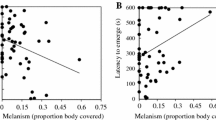Abstract
Seasons vary in the average environmental conditions a species experiences, meaning that optimum strategies for concealment or feeding may also vary. Populations of the ladybird Harmonia axyridis contain both melanic and non-melanic forms and changes in allele frequency in some populations suggest that melanism may be advantageous in winter, but costly in summer. This could favour the evolution of phenotypic plasticity in colour pattern, as individuals which changed colour throughout the year would be able to maximise their fitness. We have previously shown in the laboratory that melanisation in the “non-melanic” morph of H. axyridis, f. succinea, is predominantly controlled by temperature during development. We now report that wild populations of H. axyridis f. succinea also conform to this principle: lower field temperatures during development produce individuals with more and larger spots. Furthermore, we have found that the critical period of development where temperature affects the level of melanisation covers the pupal and late larval stages, and melanisation increases with the length of time spent at cold temperature. We conclude it is likely that the temperature experienced during this period is used to predict the temperature encountered as an adult. This may allow individuals to produce the level of melanisation necessary to maintain activity levels at the temperatures encountered when they emerge. The long sensitive period seen in H. axyridis may be in order to avoid mismatches between melanisation and seasonal environment.




Similar content being viewed by others

References
Alpert P, Simms EL (2002) The relative advantages of plasticity and fixity in different environments: when is it good for a plant to adjust?. Evol Ecol 16(3):285–297
Banta JA, Dole J, Cruzan MB, Pigliucci M (2007) Evidence of local adaptation to coarse-grained environmental variation in Arabidopsis thaliana. Evolution 61(10):2419–2432. doi:10.1111/j.1558-5646.2007.00189.x
Bradshaw WE, Holzapfel CM (2007) Evolution of animal photoperiodism. Annual Rev Ecol Evol Syst 38:1–25. doi:10.1146/annurev.ecolsys.37.091305.110115
Brakefield PM, French V (1999) Butterfly wings: the evolution of development of colour patterns. Bioessays 21(5):391–401
Brakefield PM, Reitsma N (1991) Phenotypic plasticity, seasonal climate and the population biology of Bicyclus butterflies (Satyridae) in Malawi. Ecol Entomol 16(3):291–303
Brakefield PM, Gates J, Keys D, Kesbeke F, Wijngaarden PJ, Monteiro A, French V, Carroll SB (1996) Development, plasticity and evolution of butterfly eyespot patterns. Nature 384(6606):236–242
Dobzhansky T (1924) Die geographische und individuelle Variabilität von Harmonia axyridis Pall. in ihren Wechselbeziehungen. Biologische Zentralblatt 44:401–421
Dobzhansky T (1933) Geographical variation in lady-beetles. Am Nat 67:97–126
Gomulkiewicz R, Kirkpatrick M (1992) Quantitative genetics and the evolution of reaction norms. Evolution 46(2):390–411
Grill CP (1999) Development of colour in an aposematic ladybird beetle: The role of environmental conditions. Evol Ecol Res 1(6):651–662
Hendry AP, Kinnison MT (2001) An introduction to microevolution: rate, pattern, process. Genetica 112:1–8
Hosino Y (1940) Genetical studies on the pattern types the lady-bird beetle, Harmonia axyridis Pallas. J Genet 40(1/2):215–228
Jiang W, Pan X, Liu J, Liu L (2008) Studies on the type of spot on the wing of Harmonia axyridis (Pallas) in Baoding. Hebei J Forest Orch Res 22:198–202
Jing Y, Zhang Y (2001) Studies on the type of spot on the wing of Harmonia axyridis (Pallas) in Shanxi Province. J Shanxi Agric Univ 4:42–45
Komai T (1956) Genetics of ladybeetles. Adv Genet Incorp Mole Genet Med 8:155–188
Kooi RE, Brakefield PM (1999) The critical period for wing pattern induction in the polyphenic tropical butterfly Bicyclus anynana (Satyrinae). J Insect Physiol 45(3):201–212
Levins R (1968) Evolution in changing environments. Princeton University Press, Princeton
Michie LJ, Mallard F, Majerus M, Jiggins F (2010) Melanic through nature or nurture: genetic polymorphism and phenotypic plasticity in Harmonia axyridis. J Evol Biol 23(8):1699–1707
Pinheiro J, Bates D (2000) Mixed-effects models in S and S-PLUS. Springer, Berlin
Reed TE, Waples RS, Schindler DE, Hard JJ, Kinnison MT (2010) Phenotypic plasticity and population viability: the importance of environmental predictability. Proc Royal Soc Lond Ser B Biol Sci 277(1699):3391–3400. doi:10.1098/rspb.2010.0771
Reznick DN, Ghalambor CK (2001) The population ecology of contemporary adaptations: what empirical studies reveal about the conditions that promote adaptive evolution. Genetica 112:183–198
Rountree DB, Nijhout HF (1995) Hormonal control of a seasonal polyphenism in Precis coenia (Lepidoptera, Nymphalidae). J Insect Physiol 41(11):987–992
Salamin N, Wuest RO, Lavergne S, Thuiller W, Pearman PB (2010) Assessing rapid evolution in a changing environment. Trend Ecol Evol 25(12):692–8
Shapiro AM (1976) Seasonal polyphenism. Evol Biol 9:259–333
Tan CC (1946) Mosaic dominance in the inheritance of color patterns in the lady-bird beetle, Harmonia axyridis. Genetics 31(2):195–210
Tan CC, Li JC (1934) Inheritance of the elytral color patterns of the lady-bird beetle, Harmonia axyridis Pallas. Am Natur 68:252–265
Trullas SC, van Wyk JH, Spotila JR (2007) Thermal melanism in ectotherms. J Therm Biol 32(5):235–245
Via S, Gomulkiewicz R, deJong G, Scheiner SM, Schlichting CD, Vantienderen PH (1995) Adaptive phenotypic plasticity—consensus and controversy. Trend Ecol Evol 10(5):212–217
Yuan R, Zhang F, Wen G (1994) Color pattern of Harmonia axyridis in Changbai Mountains. Jilin Agric Sci 4:45–54
Acknowledgements
We thank Emma Rhule and Ian Wright for assistance with practical work. FMJ is funded by a Royal Society University Research Fellowship.
Author information
Authors and Affiliations
Corresponding author
Electronic supplementary material
Below is the link to the electronic supplementary material.
Rights and permissions
About this article
Cite this article
Michie, L.J., Masson, A., Ware, R.L. et al. Seasonal phenotypic plasticity: wild ladybirds are darker at cold temperatures. Evol Ecol 25, 1259–1268 (2011). https://doi.org/10.1007/s10682-011-9476-8
Received:
Accepted:
Published:
Issue Date:
DOI: https://doi.org/10.1007/s10682-011-9476-8



